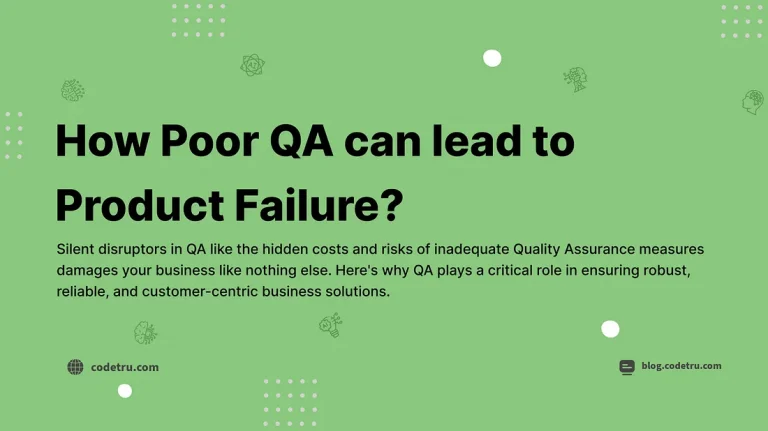In the dynamic landscape of product development, the importance of Quality Assurance (QA) cannot be overstated. QA serves as the guardian of product integrity, playing a pivotal role in preventing failure and ensuring customer satisfaction.
In the realm of software development, QA is a vital process that ensures the final product meets the expectations of the customers and the stakeholders. QA involves testing the software for functionality, usability, compatibility, security, and performance.
It is important to note that, QA is not just a phase that happens at the end of the development cycle. It is a continuous process that spans across the entire software development life cycle (SDLC). A thoroughly checked product helps to prevent product failure by identifying and resolving potential issues before they become costly and damaging.
The Impact of Poor QA
Quality Assurance, at its core, involves systematic processes to ensure that a product meets specified requirements and standards. Poor QA practices can have severe consequences, leading to product failure. Recent statistics reveal a concerning rate of product failures attributed to inadequate quality assurance tests, emphasizing the critical need for robust quality control.
Consequences of Poor QA Practices
Poor QA practices can lead to product failure in many ways. Some of the common consequences of poor QA are:
1. Bugs and defects
Poor QA can result in software that is full of bugs and defects that affect the functionality, usability, and security of the product which can lead to customer dissatisfaction, loss of trust, and can go as far as legal liabilities. According to a report by the Consortium for IT Software Quality (CISQ), the cost of poor quality software in the US in 2018 was estimated at $2.08 trillion1.
2. Delays and Overruns
A study by the Standish Group found that only 29% of software projects in 2015 were successful, while 19% were failed and 52% were challenged. The main reasons for project failure were poor requirements, lack of user involvement, and inadequate testing
3. Competitive Disadvantage
Poorly conducted quality assurance can make you unprepared for the market and also result in software that is inferior to the competitors’ products, leading to loss of market share, reputation, and revenue. A survey by Dimensional Research found that 61% of consumers have switched to a competitor’s product due to poor software quality3.
Real-World Examples of QA-Related Product Failures
Quality assurance and software testing lays the foundation for the success of any product in the market. Straying from these crucial principles can trigger catastrophic consequences
There are many examples of product failures due to poor QA in the history of software development. Some of the notable ones are:
The Ariane 5 Rocket Explosion
In 1996, the European Space Agency launched the first flight of the Ariane 5 rocket, which exploded 37 seconds after liftoff, resulting in a loss of $370 million. The cause of the failure was a software bug that caused an overflow error in the rocket’s guidance system. The bug was not detected during testing because the software was reused from the previous Ariane 4 rocket, which had different specifications and requirements.
The Knight Capital Trading Glitch
In 2012, Knight Capital, a leading market maker in US equities, suffered a trading glitch that caused it to lose $440 million in 45 minutes. The glitch was caused by a faulty software update that was not properly tested and deployed. The update triggered millions of erroneous trades that drove up the prices of 148 stocks.
The Boeing 737 Max crashes
In 2018 and 2019, two Boeing 737 Max planes crashed, killing 346 people. The crashes were attributed to a faulty software system called MCAS, which was designed to prevent the plane from stalling. The system relied on a single sensor that was prone to malfunction, and it repeatedly pushed the nose of the plane down, overriding the pilots’ commands. The system was not adequately tested and verified, and the pilots were not properly trained on how to handle it.
Samsung Galaxy Note 7 Battery Explosions
The Galaxy Note 7 suffered from battery defects that caused explosions and fires. This failure led to a massive global recall, costing Samsung billions in lost revenue and tarnishing its brand reputation. The root cause was traced back to poor QA in battery manufacturing.
These failures spurred industry-wide reforms in QA methodologies and emphasized the significance of proactive quality assurance throughout the product development lifecycle.
Trends in QA and Product Development
QA and product development are constantly evolving and adapting to the changing needs and expectations of the customers and the market. Some of the emerging QA trends that are reshaping traditional QA practices, making them more efficient and effective are:
Test Automation
Test automation is the use of software tools to perform testing tasks that are repetitive, time-consuming, or error-prone, such as regression testing, performance testing, and load testing. It can improve the efficiency, accuracy, and coverage of testing, as well as reduce the cost and time of testing. According to the World Quality Report 2020–21, the level of test automation has increased from 14% in 2015 to 45% in 20204.
AI integration
Artificial Intelligence (AI) is revolutionizing QA by enhancing predictive analytics, enabling smarter testing strategies, and identifying patterns to predict potential issues before they arise.
These trends are shaping the future of product development and QA practices, as they enable faster, smarter, and more reliable testing and quality assurance.
Predictions on QA Impact on Product Success
As QA becomes more integrated and influential in the product development process, it also becomes more predictive and proactive in ensuring product success.
Predictive Analytics
Predictive analytics is the use of data analysis and statistical modeling to forecast future outcomes and trends. Predictive analytics can help QA to anticipate and prevent potential issues, such as defects, risks, and customer feedback before they affect the product quality and performance. According to the World Quality Report 2020–21, 57% of organizations are using predictive analytics for QA and testing, and 43% are planning to do so in the future4.
Shift-left Testing
Shift-left testing is the practice of moving testing activities earlier in the SDLC, such as during the requirements, design, and development phases. Shift-left testing can help QA to detect and fix issues sooner, reduce rework, and improve collaboration and feedback.
These predictions show how QA can play a more strategic and proactive role in ensuring product success, by using data-driven and agile approaches to testing and quality assurance.
Best Practices for QA to Prevent Product Failure
To prevent product failure and ensure product success, some best practices and methodologies can help to improve the quality and reliability of the software products. Some of the best practices for QA are:
Define Clear and Realistic Requirements
Requirements are the foundation of any software product, and they need to be clear, realistic, and aligned with the customer and stakeholder expectations. It needs to be involved in the requirements elicitation and analysis process, to ensure that the requirements are testable, verifiable, and traceable.
Adopt Agile Development
Agile development is a methodology that emphasizes iterative, incremental, and collaborative development, with frequent delivery of working software. It can help improve the speed, flexibility, and responsiveness of testing and quality assurance, as well as increase customer satisfaction and feedback. We also need to adopt agile practices, such as Scrum, Kanban, and DevOps, to integrate testing and quality assurance into the development process, and to ensure continuous testing and delivery.
Use Appropriate Testing Tools and Techniques
Testing tools and techniques are how testing and quality assurance activities, such as test design, execution, reporting, and automation are carried out. We need to use appropriate testing tools and techniques that suit the needs and characteristics of the software product, such as the type, size, complexity, and functionality of the product.
Conclusion
Quality Assurance stands as a cornerstone in product development. Its effective implementation is pivotal for delivering high-quality products, maintaining customer satisfaction, and safeguarding brand reputation. By embracing emerging technologies, adopting proactive strategies, and prioritizing quality throughout the development lifecycle, organizations can ensure product success while mitigating the risks associated with product failure.
FAQs about Poor QA on Product Failure
1. What are the common signs of poor QA in software development?
Common signs of poor QA include frequent software bugs, inconsistent performance across different environments, slow release cycles, and an increase in user complaints or support tickets. These issues often indicate that the quality assurance process was inadequate, leading to defects slipping through and impacting the end-user experience.
2. How can poor QA practices lead to financial losses for companies?
Poor QA practices can lead to significant financial losses through various channels. These include the cost of fixing defects after release, potential legal liabilities from security breaches, loss of customer trust, and diminished market share due to competitive disadvantages. Studies, such as those by the Consortium for IT Software Quality, have highlighted that inadequate QA can result in billions of dollars in losses annually.
3. What role does automated testing play in preventing product failure?
Automated testing plays a crucial role in preventing product failure by improving the efficiency and coverage of the QA process. It allows for consistent and repeatable testing of software components, identifies issues early in the development cycle, and reduces the risk of human error. Implementing automated tests for regression, performance, and load scenarios can significantly enhance product reliability.
4. How does AI integration improve Quality Assurance processes?
AI integration enhances Quality Assurance by leveraging advanced algorithms to predict potential issues, optimize testing strategies, and identify patterns that may not be immediately obvious. AI-driven tools can provide predictive analytics, automate test case generation, and enhance defect detection, leading to more robust and proactive QA processes.
5. What are the best practices for implementing QA to avoid product failures?
Best practices for implementing QA include defining clear and realistic requirements, adopting agile methodologies for iterative testing, using appropriate testing tools and techniques, and integrating continuous testing throughout the development lifecycle. By ensuring these practices are followed, organizations can enhance product quality and mitigate the risk of failures.





